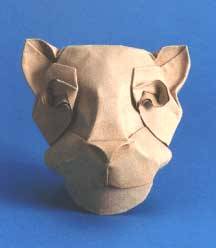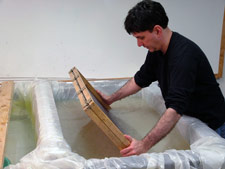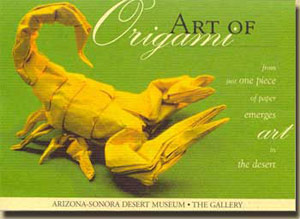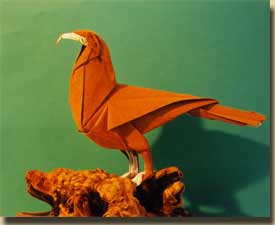Michael LaFosse: Interpretations in Origami - Animals of the Sonoran Desert
Friends of Dard Hunter's Bull & Branch, 1998
by Catherine Nash

Life-sized origami mask of a mountain lion was folded from a single, 18-inch square of agave and cotton fiber paper, hand made by Michael LaFosse.In the collection of John Robertson.
Photo by Michael Lafferty |
A friendly phone call in February of 1997, piqued my interest and sense of adventure. Master origami artist Michael LaFosse was just beginning a stint as “artist-in-residence” at the Arizona-Sonora Desert Museum in Tucson. Education staff connected us because of our mutual interests: I had taught Japanese and Western papermaking from plant fibers at the museum on several occasions. Michael’s unique proposal,
to study the Sonoran Desert plants and animals, and then design origami renditions of them in his own handmade paper, was intriguing to me. A quick drive over the Tucson Mountains and I was soon listening to his wonderful story.
Just how this exhibit came about starts with Michael’s invitation
in 1995 to be a guest artist at the annual Matsuri (Festival of Japan) in Phoenix. During a quick visit afterwards to Tucson, Michael fell in love with the AZ Sonoran Desert Museum. A living museum in the heart of a lush desert terrain of saguaro, cholla, and prickly pear cactus, the Desert Museum is home to over 300 different species of unique desert insects, mammals, reptiles, fish and birds - plenty of inspiration for an origami artist
with a keen appreciation of nature.
During the month of February, 1997, Michael returned to live on-location, for what he describes as “an intense gathering of natural history data”. He observed and documented the stances, gestures, and movement of the desert animals in this “living museum” with sketchbooks, videotape, and still photographs. He made multitudinous pencil sketches of gestures and recorded details of the animals and plants, taking mental notes on color and textural palettes.

Michael demonstrates hand papermaking in the Japanese tradition of nagashizuki.
photo by Richard Alexander |
Michael’s favorite subjects were the jaguarundi (a smallish mountain lion), the sidewinder rattlesnake and the scorpion. Living on the Museum premises in a rustic stone cabin, Michael was given an up-close encounter one time as a bark scorpion climbed the shower wall. The museum staff allowed him behind-the-scenes opportunities to get up-close for better views.
Returning to his Origamido Studio in Haverhill, MA, armed with all his documentation, Michael worked for a full year developing his original origami creations. LaFosse develops the structural system of a new origami design in his head: visualizing
the paper folding, he rehearses the steps in his mind until he is ready to create his paper studies. His efforts intensify as he becomes more technically involved in the details. He creates all his own handmade paper for his original origami, designing
appropriate color and visual textures to correspond to his close observation of his subject and nature.Origami poses some limitations to those working from observations of living subjects. “It’s an abstract art form”, LaFosse says, “The boiling down of the essence of the subject demands simplicity...the paper is the flesh and the folds are the bones.”

Promotional postcard for the exhibit: "Animals of the Sonoran Desert", 1998, Arizona Sonora Desert Museum.
Photo by Richard L. Alexander. |
In early February of 1998, Michael LaFosse installed Animals of the Sonoran Desert, an exhibition of unique origami designs in the Ironwood Gallery at the AZ Sonoran Desert Museum in Tucson, AZ. His structural and textural interpretations are fascinating. The fact that he used unique handmade papers (some of which were made from desert agave fibers), pigmented in a palette of desert colors, heightened the visual effect tremendously. The Desert Museum will keep only about 10 major pieces, and is considering the idea of presenting them as the nucleus of a traveling exhibit.
Affectionately nicknamed the “Origami Kid”, Michael LaFosse has had an intense passion for the art of paper folding since he was 7 years old. He would practice a variety of traditional designs: the balloon, crane, boat, hat and frog and enjoyed teaching them to all his friends. Eager to learn more, Michael would scour the libraries and bookstores for new information on the art.
At age twelve, the discovery of a Reader’s Digest article on Akira Yoshizawa, a renowned Japanese Origami master was an indelible moment of focus in LaFosse’s young career. “The idea that one could invent new designs had never occurred to me. I thought everything possible had already been designed generations ago.” That Yoshizawa, the designer of tens of thousands of original origami creations, observed nature directly for inspiration especially affected him and remains one of Michael’s tenants to this day. The examples pictured in the Reader’s Digest article about Yoshizawa’s work were so alive with vision and artistry, Michael suddenly understood the potency of origami as an art form. Through those photos Yoshizawa’s art struck a chord. “...And I thought, ‘That’s me!’ At the age of twelve, I knew in my heart that I too would become an origami artist.”
Though Michael went on to major in marine biology, he continued the pursuit of his art and designed hundreds of new creations and developed his papermaking skills. Finally, in 1991, after nearly 20 years of study, LaFosse came face to face with the man responsible for instilling a passion for designing origami, Akira Yoshizawa.
Already an accomplished artist with his works internationally known, Michael took a origami masters class with Yoshizawa in Ossining, NY. Familiar with Japanese protocol and Yoshizawa’s reputation as a renowned Master, LaFosse quietly and humbly participated in the class. “If I had anything to show the master it would not be through my original creations, but rather through my efforts under his direction
in this class.” As Yoshizawa observed each of the participants’ work, he would offer criticism. When he saw Michael’s project,Yoshizawa spontaneously hugged Michael with praise.
Originally, Akira Yoshizawa worked as a draftsman in an iron fabrication plant. His powerful mind was able to visualize angles and geometric structures. It was a natural step to document his prolific output of creative origami designs, resulting in some of the earliest published origami. He developed the standardized diagramming system still used today. By melding these technical abilities over a lifetime of close observation of nature and meditative expressiveness, Yoshizawa has created a body of original designs that were, and are still a great inspiration to LaFosse.
Michael’s 1995 meeting with Yoshizawa was arranged formally. Finally, in the Tokyo studio, Michael showed the master the tattered, yellowed copy of the original Reader’s Digest article from 1970. It was an emotional moment and brought tears to Yoshizawa’s eyes. More recently, in 1997, Michael arranged for Mr. and Mrs. Yoshizawa to return to the United States, with an extensive exhibit of Yoshizawa’s original origami at the Peabody-Essex Museum in Salem, Massachusetts.
LaFosse’s hometown of Fitchberg, Massachusetts is historically a papermaking town, full of paper mills and textile factories. School buddies, whose dads worked in the paper mills, would bring in pulp and screens for “show-and-tell”. The local library also had an extensive collection of books on papermaking. As Michael kept looking at the photos of Yoshizawa’s work in the Reader’s Digest, he realized he could not achieve the same effect with readily available paper. He began to experiment with making his own paper at age sixteen. He pulped some brown paper bags in a kitchen blender and tried to dry the sheets between newsprint.

Michael LaFosse, Harris Hawk, designed and folded from a single 18-inch square of agave and cotton fiber paper, colored white on one side and brown on the other. For the ASDM exhibit.
Photo by Michael G. LaFosse |
His impatience led to a “Eureka!” discovery. As he started to fold with the damp sheets, LaFosse realized that he could shape and sculpt the foldings producing a soft 3D effect. As the origami dried, the models hardened and retained the shape he fashioned when wet. It wasn’t until years later that he found out that he had stumbled onto the secret of Yoshizawa’s work - the technique of “wet-folding”.
Eventually, LaFosse taught himself the Japanese sheetforming technique of nagashizuki. He remembers
buying neri root in an alternative medical store in Boston, where the mucilage was being sold as a moisturizer as well as to heal bruises. Combining the neri with his boiled handbeaten fiber (from an old linen tablecloth)
Michael made his first sheets of Japanese style paper. (Although living in Massachusetts, he did not meet Elaine and Donna Koretsky of Carriage House Paper in Brookline until the late 1980s.)
Michael LaFosse’s finesse with handmade paper has evolved to the exquisitely designed sheets he creates for each unique original design. He may well be the only origami artist in the world who does this. Although
primarily he works from his own paper, he is also inspired by handmade sheets form local studios such as Rugg Road and Carriage House Paper.
Michael’s paper fibers of choice are abaca and second cut cotton linters, blended to varying degrees. Sometimes they are beaten in a Hollander beater to his specifications or simply rehydrated with a “Whiz-Mixer”. He uses handbeaten mulberry bark fiber or pure abaca for nagashizuki sheetforming. He creates huge sheets eight by eight feet ( 2.5 X 2.5 meters) from overbeaten, high-shrinkage abaca either sprayed onto a stretched cloth or poured with formation aid into a drain box and then dried under restraint.LaFosse can create various qualities of surface texture in his papers. Smooth papers result from his brushing the sheets onto glass. Most often, he dries his post in a Santa Ana dryer. For wet folding, sheets need extra strength which he achieves with internal sizing such as Ketene Dimer. For wet strength, instead of externally using traditional konnyaku paste, he brushes on methyl cellulose. For strong, stiff, yet very thin sheets, two nagashizuki style sheets will be pasted together with methyl cellulose and dried taped to a board, then cut to shape and size.
Wet folding involves spraying a light misting of water to both sides of the sheet. This creates a yielding quality in the paper. The best comparison, LaFosse says is “leather-hard” in ceramics: pliable but still strong. Sometimes he uses clay tools to help manipulate the folding (to open an eye for instance) and to create clean creases.
Michael LaFosse has an “important message for lovers of handmade paper.” He wants us to know that: “Although different countries had traditional folded designs such as China, Korea, Japan, Spain, Islam, and Italy (Leonardo da Vinci’s famous airplane is the common flying dart), Akira Yoshizawa was the most significant artist proponent of original origami design. Sixty years ago, the work of Yoshizawa single-handedly became responsible for the Renaissance of origami right now.”
“Yes, we are definitely in the ‘Golden Age’ of origami art. Thousands regard origami as a viable, modern, and international art form, not an ancient Japanese art at all, and it’s truly been adopted by talented, creative minds in over 50 countries. Those interested in handmade paper might want to take a second look at it.”
Bio
Michael G. LaFosse has been an origami artist for over 40 years, and is considered a leading authority and master of the art. An avid teacher, LaFosse co-founded the Origamido Studio, a learning center and design studio dedicated to the art of origami, and the only place in the world specializing in hand papermaking for the origami artist. Author of many books and videotapes relating to paperfolding and hand papermaking, LaFosse produces fine paper art and commercial designs for a variety of international clients. Both Michael LaFosse and Richard Alexander co-founders of Origamido Studio, appear in the Peabody Award-winning film, “Between the Folds”, which recently aired nationwide on PBS: betweenthefolds.com
Michael LaFosse can be reached at: Origamido Studio
|
|

